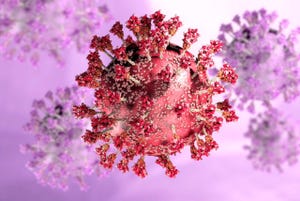Google Glass as a Remote Rapid Test Reader Demonstrated
March 6, 2014
|
Researcher reads a rapid test using Google Glass app. (Courtesy Feng, et al.) |
Researchers from the Electrical Engineering and Bioengineering Departments of the University of California, Los Angeles, (UCLA) and the California Nanosystems Institute (CNI) have collaborated to develop a rapid diagnostic test (RDT) reader for the Google Glass device that is capable of returning results from various lateral-flow immunochromatographic assays and similar medical diagnostic rapid tests within seconds.
A paper published online on ACS Nano, "Immunochromatographic Diagnostic Test Analysis Using Google Glass," describes their work and details their validation testing.
The app uses Google Glass' built-in camera without any external hardware attachments. The researchers used the Google Glass beta Explorer Edition for their tests. Lead author Steve Feng, et al.; wrote, "This wearable computational platform allows for rapid hands-free imaging and processing of any number of RDTs, which can be very useful for disease and medical condition testing and monitoring in remote locations, disaster relief areas, or quarantine zones.
Users capture an image of the activated test which is uploaded by the app to a server for evaluation.
Next, the team wrote, "the server processes the test image, and the result is returned to the Glass and displayed to the user in the form of a 'result card'...[which is] populated with the cropped image region, test type, test validation (valid/invalid), and assessment of the diagnostic results (positive/negative and/or concentration level, for qualitative and quantitative tests, respectively)." The researchers say that results of the test can be returned to the user's Glass device, also wirelessly, in as little as 8 seconds.
A web portal allows users to view their test results and cumulative data from all the tests the user has submitted over time. Results are also charted using Google Maps to show the geographical spread of various diseases and conditions.
Last author Aydogan Ozcan, PhD, professor of electrical engineering and bioengineering at UCLA and CNI associate director, told the UCLA Newsroom's Thomas Bill Kisliuk, "This smart app allows for real-time tracking of health conditions and could be quite valuable in epidemiology, mobile health and telemedicine."
The team used a home HIV test and an off-the-shelf prostate-specific antigen (PSA) test to see how well their creation worked. Under normal conditions, the RDT reader and server platform were able to read 99.6 percent of the images. In 100 percent of the images that were successfully read, accurate and quantified test results were returned, the team said. They also tried uploading more than 300 images with motion blur and misaligned codes to their server and were still able to achieve reads of 96.6 percent of the images. The majority of failures, they say, were caused by motion blur or "a significant out-of-plane tilt compared to the Glass."
Stephen Levy is a contributor to Qmed and MPMN.
About the Author(s)
You May Also Like



